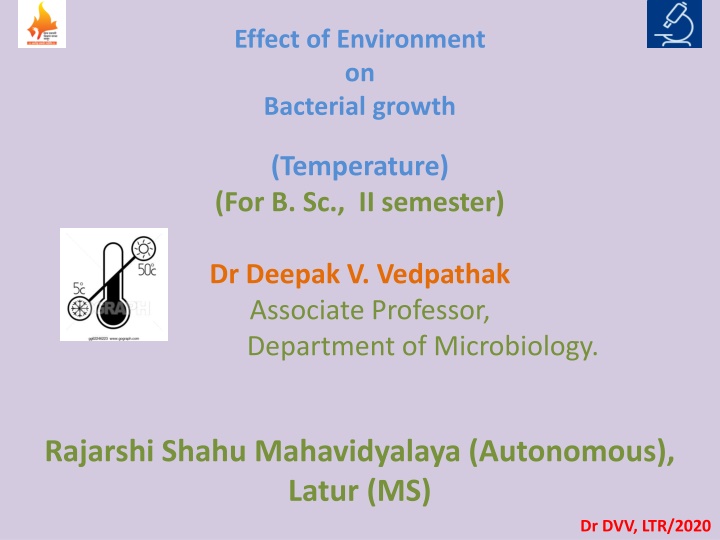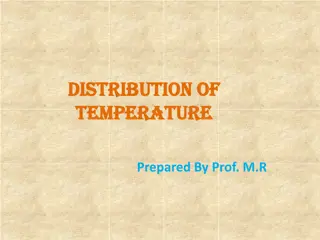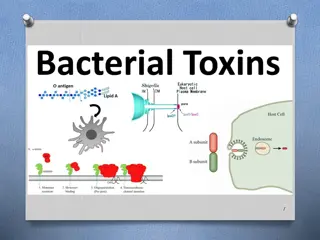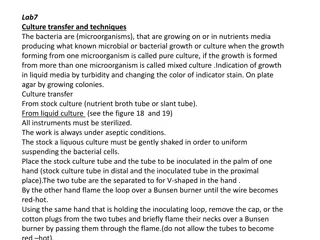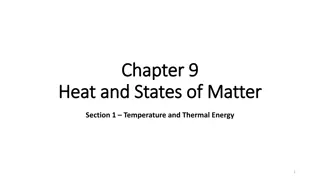Effects of Temperature on Bacterial Growth
The impact of low and high temperatures on bacterial growth, including membrane solidification, denaturation of proteins, and adaptation mechanisms of psychrophiles. Explore cardinal temperature points and categories based on optimum temperature for microbial growth.
Download Presentation

Please find below an Image/Link to download the presentation.
The content on the website is provided AS IS for your information and personal use only. It may not be sold, licensed, or shared on other websites without obtaining consent from the author.If you encounter any issues during the download, it is possible that the publisher has removed the file from their server.
You are allowed to download the files provided on this website for personal or commercial use, subject to the condition that they are used lawfully. All files are the property of their respective owners.
The content on the website is provided AS IS for your information and personal use only. It may not be sold, licensed, or shared on other websites without obtaining consent from the author.
E N D
Presentation Transcript
Effect of Environment on Bacterial growth (Temperature) (For B. Sc., II semester) Dr Deepak V. Vedpathak Associate Professor, Department of Microbiology. Rajarshi Shahu Mahavidyalaya (Autonomous), Latur (MS) Dr DVV, LTR/2020
Effect of low temperature: Membranes lipid solidifies, lose their fluidity and are damaged by ice crystal formation Chemical reactions and diffusion process slow considerably Proteins become too rigid to catalyze reactions and may undergo denaturation Effect of high temperature: Denaturation of proteins including enzymes and nucleic acids Membrane lipid melts Increased fluidity harm metabolic processes in membranes Dr DVV, LTR/2020
LEARNING OBJECTIVES Cardinal temperature points: Any microorganism can grow within a range of temperatures. The highest temperature at which growth can occur is its maximum growth temperature The lowest temperature at which the organism can survive and replicate is its minimum growth temperature The temperature at which the growth rate is highest is the optimum growth temperature Dr DVV, LTR/2020
Categories based on optimum temperature Dr DVV, LTR/2020
Categories . Psychrophiles: Grow at 0 C and below, have an optimum growth temperature about 15 C, and do not survive above 20 C Arthrobacter flavus, Psychrobacter arcticus, Glutamicibacter soli, Pseudarthobacter chlorophenolicus Psychrotrophs (psychrotolerant): Prefer cooler environments, from a high temperature of 25 C to refrigeration temperature about 4 C. They are responsible for the spoilage of refrigerated food. Dr DVV, LTR/2020
Mechanism of adaptation of psychrophiles Proteins in psychrophiles are rich in hydrophobic residues and display an increase in flexibility Proteins have a lower number of secondary stabilizing bonds. Antifreeze proteins and solutes that decrease the freezing temperature of the cytoplasm play a protective role The lipids in the membranes tend to be unsaturated therefore remain liquid. Growth rates are much slower than those encountered at moderate temperatures. Dr DVV, LTR/2020
Thermophiles: Organisms that grow at optimum temperatures of 50 C to a maximum of 80 C Alicyclobacillus acidocaldarius, Alicyclobacillus acidoterrestris, Thermus aquaticus,Geobacillus stearothermophilus, Methanopyrus kandleri Archaea Pyrobolus spp. and Pyrodictium spp. grow at 105 C and survive autoclaving. Thermoduric bacteria: Bacteria which can survive the high temperatures such as the pasteurization process. Species of bacteria which are thermoduric include Bacillus, Clostridium and enterococci. Dr DVV, LTR/2020
Applications of thermophiles The thermoenzyme Taq polymerase isolated from T. aquaticus has an important practical application in amplification of nucleic acids in the polymerase chain reaction (PCR) Degradation enzymes from thermophiles are added as ingredients in hot-water detergents, increasing their effectiveness. Dr DVV, LTR/2020
Mechanism of adaptation of thermophiles The ratio of saturated to polyunsaturated lipids increases to maintain maximum fluidity of the cell membranes. Their DNA sequences show a higher proportion of guanine cytosine nitrogenous bases, which are held together by three hydrogen bonds in contrast to adenine and thymine, which are connected in the double helix by two hydrogen bonds. Additional secondary ionic and covalent bonds, as well as the replacement of key amino acids to stabilize folding, contribute to the resistance of proteins to denaturation. Dr DVV, LTR/2020
Mesophiles: Optimal growth temperatures ranging from room temperature (about 20 C) to about 45 C. E. coli, Staphylococcus spp., Salmonella spp., Lactobacillus spp., Azotobacter spp., Rhizobium spp., Pseudomonas spp. Dr DVV, LTR/2020
Mechanism of adaptation of thermophiles Dr DVV, LTR/2020
